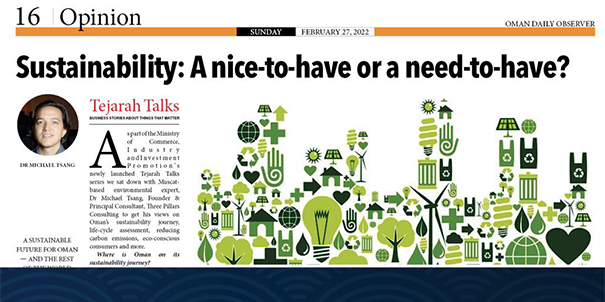Sustainability: A Nice-To-Have or a Need-To-Have?
Written By: Michael Tsang, Ph.D. | Originally Published in the Oman Observer | Date: February 26, 2022

Where is Oman on its sustainability journey?
Oman has been on a good trajectory for the past few years, for example, starting with the release of small-scale solar photovoltaic regulations in 2017, which kicked off a significant buzz around renewable energy in the country. That trend has continued, resulting in deployment of both small and large-scale renewable energy projects, as well as the country setting targets like 30% of all electricity production being renewable by 2030 and reducing its GHG emissions by 7% over that same time-period. More recently, the conversation has shifted towards emerging technologies such as green hydrogen and green molecules to address issues such as renewable energy storage, the sustainability of liquid fuel sources, and other energy requirements. There are other creative projects coming out of Oman, such as 44.01, which is a company developing a method for carbon capture and carbon storage solutions here in the country. That being said, a sustainable future for Oman – and the rest of the world for that matter – will need to include a mix of technologies and range of solutions along their sustainable journey. There is not one specific approach alone that can solve all energy, resource, and emissions challenges.
How do you advise companies about setting sustainability goals knowing there are so many directions they can go in terms of trying to deliver the impact they want to see?
Sustainability means different things to different companies and organizations depending on the sector they are in. It might mean setting energy reduction targets for one company, water reduction targets for another, and yet solid waste reduction for others, for example. Whatever is the case, our process is always the same; establish a baseline for their environmental impact of concern, identify possible mitigation options, evaluate the environmental impacts of those options, and compare them to the baseline. Once potential impact reductions are identified, then we work with the company to establish key performance indicators that are most suitable for their organization, given their budget, resources, and preferences. We can provide this type of analysis on so many different sustainability goals by using life-cycle assessment, which is a set of standards and methods that allows us to model multiple environmental impacts across the entire supply chain of a company and its products in one go.
When does it make sense for companies to invest in sustainability initiatives?
Companies should be looking immediately for ways to understand the environmental footprint of their products and their organization. Sustainability is already a key differentiator used by governments, clients, and consumers when choosing which products and services to purchase. Moreover, regulations and policies for energy efficiency and carbon reductions will only get more stringent each year in order to reduce emissions enough to be in line with the 1.5C warming scenario outlined by the IPCC.
In practical terms, what is the first step Omani businesses, particularly small firms, can take on their sustainability journey?
The first step would simply having a basic idea of what their energy consumption and carbon emissions are for their company. To borrow a phrase from conventional business management, “if you can’t measure it, you can’t improve it.” Going beyond that, if you can’t measure it, you can’t even begin to talk about it, meaning your company and product is missing out on potential market opportunities. This doesn’t have to be an expensive, complicated exercise at the beginning for smaller companies. Simply having one person keep some sort of basic table of energy, fuel, electricity consumption can already provide quite a lot of insight. If possible, converting that consumption into GHGs will get you at least a reasonable understanding of your Scope 1 and Scope 2 greenhouse gas emissions.
What do you see as the sustainability challenges facing Omani companies today?
Having said that, companies will ultimately find that they will need to provide robust and transparent reporting that follows international best-practices and guidance such as the Greenhouse Gas Protocol or ISO 14064:2018. This will also become important when assessing one’s Scope 3 emissions, which can be a challenge for any company large or small since it includes the entire value chain. For example, a recent client of ours had approached us to validate and verify some calculations they had made on potential GHG reductions they calculated when switching from wooden to recycled plastic pallets used for shipping their products. After doing a full analysis of the embodied carbon for their Scope 3 emissions, the results showed that a single-use (one way) wooden pallet is environmentally preferred compared to a single-use (one-way) recycled plastic pallet. This is a common situation that we see, namely that perceived environmental benefits are not always guaranteed, and it is only possible to definitively say this after conducting a GHG assessment across the life-cycle.
Looking for Expert Analysis?
Send us an email or schedule a call with us to discuss your questions and needs regarding carbon, energy, and sustainability.
Contact
Want to contact us about our services and products? Give us a call or send us a message by using the form below.
Location:
Three Pillars Consulting (TPC)
Al Noor Plaza (Building 2118), Unit 107
Al Bashair Street | Madinat Sultan Qaboos, Muscat | Oman
Postal Code 116
Email:
contact@threepillarsgroup.com
Call:
+968 2496 7611
